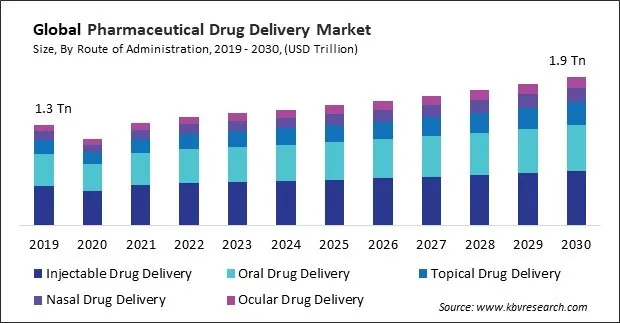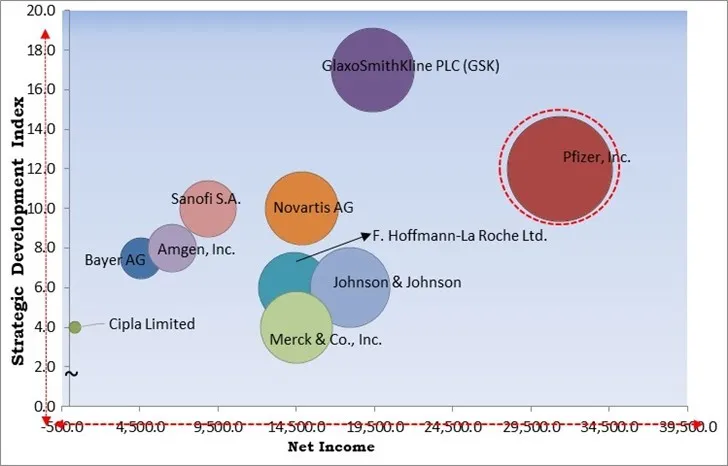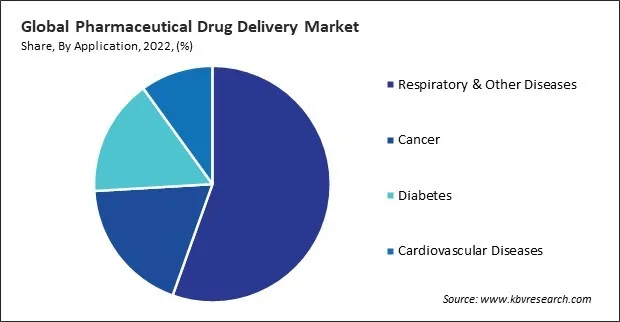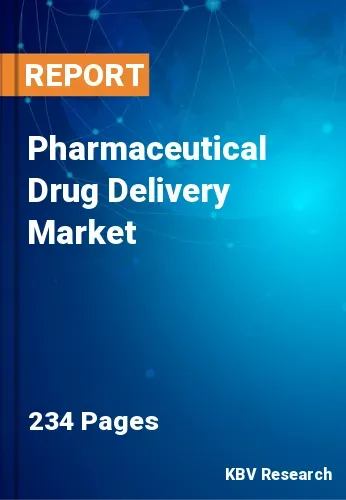“Global Pharmaceutical Drug Delivery Market to reach a market value of USD 1.9 Trillion by 2030 growing at a CAGR of 4.1%”
The Global Pharmaceutical Drug Delivery Market size is expected to reach $1.9 trillion by 2030, rising at a market growth of 4.1% CAGR during the forecast period.
Topical drug delivery is used in dermatology to treat various skin conditions, including dermatitis, psoriasis, acne, eczema, and fungal infections. Topical formulations such as creams, ointments, and gels are applied directly to the affected skin, delivering medications to the site of action. Consequently, the topical drug delivery segment would generate approximately 15.03% share of the market by 2030. Topical drug delivery is employed in ophthalmic applications to treat eye conditions like glaucoma, conjunctivitis, and dry eye syndrome. Eye drops, ointments, and gels are applied directly to the eyes, allowing for targeted and efficient drug delivery to the ocular tissues.

The major strategies followed by the market participants are Mergers & Acquisition as the key developmental strategy to keep pace with the changing demands of end users. For instance, In October 2023. Amgen, Inc., a pharmaceutical company, has completed the acquisition of Horizon Therapeutics plc, a biopharmaceutical company. Through this acquisition, Horizon will help to further establish Amgen as a leader across a broader range of diseases. Furthermore, the companies will collaborate to serve even more patients worldwide who are suffering from serious illnesses.
Based on the Analysis presented in the KBV Cardinal matrix; Pfizer, Inc. is the forerunner in the Market. In October 2022, Pfizer, Inc., a biopharmaceutical company, took over Global Blood Therapeutics, Inc., a biopharmaceutical company. Through this acquisition, Pfizer will incorporate the portfolio of Global Blood Therapeutics, which will accelerate innovation and the timely introduction of multiple potential best-in-class treatments for people living with sickle cell disease. And Companies such as GlaxoSmithKline PLC (GSK), Johnson & Johnson, and Novartis AG are some of the key innovators in Market.

Increased research and development (R&D) investments enable the development of advanced drug formulations. Novel formulations, including liposomes, nanoparticles, and microparticles, enhance drug solubility, bioavailability, and targeted delivery, improving therapeutic efficacy. Biopharmaceuticals and biosimilars represent a growing segment in drug development. Therefore, the market is expanding significantly due to the increasing investments in research and development.
Nasal drug delivery provides a non-invasive and patient-friendly alternative to traditional routes such as injections. The ease of administration enhances patient compliance and comfort, contributing to the growing adoption of nasal drug delivery systems. The nasal route provides direct access to the CNS through the olfactory and trigeminal nerve pathways. Thus, because of the rising adoption of nasal drug delivery, the market is anticipated to increase significantly.
High development costs may lead pharmaceutical companies to allocate limited resources to research and development. This constraint can impede the exploration of innovative drug delivery technologies, limiting the industry’s ability to develop novel, more effective solutions. High development costs can contribute to elevated drug prices. This reduced accessibility may hinder the emergence of innovative startups and disruptors, limiting fresh perspectives and novel approaches to drug delivery. Thus, high development costs can slow down the growth of the market.


Based on application, the market is classified into cancer, diabetes, cardiovascular diseases, respiratory diseases, and others. In 2022, the respiratory diseases segment witnessed the largest revenue share in the market. Inhalation is a common and effective route for administering drugs directly to the lungs. Inhalation therapies are widely used for respiratory diseases such as asthma and COPD. The pharmaceutical industry has developed inhalation devices, including metered-dose inhalers (MDIs) and dry powder inhalers (DPIs), to deliver bronchodilators, corticosteroids, and other medications directly to the respiratory system. Rising levels of air pollution globally contribute to the increasing incidence of respiratory diseases. As the global population is exposed to environmental pollutants, the demand for effective pharmaceutical interventions and drug delivery systems for respiratory health continues to grow.

By route of administration, the market is categorized into topical drug delivery, injectable drug delivery, oral drug delivery, nasal drug delivery, and ocular drug delivery. The oral drug delivery segment covered a considerable revenue share in the market in 2022. Oral drug delivery is one of the most convenient methods for patients. It involves swallowing a pill or liquid, making it widely accepted, and enhancing patient compliance with prescribed medications. Advances in formulation technologies, such as bioenhancers and nanoparticulate delivery systems, have improved the oral bioavailability of certain drugs. This optimization contributes to the effectiveness of the medication. Oral drug delivery suits many drug classes, including small molecules, peptides, and biologics. This versatility enables the delivery of diverse therapeutic agents.
Free Valuable Insights: Global Pharmaceutical Drug Delivery Market size to reach USD 1.9 Trillion by 2030
Region-wise, the market is analysed across North America, Europe, Asia Pacific, and LAMEA. In 2022, the Asia Pacific region acquired a significant revenue share in the market. The Asia-Pacific region has witnessed a proliferation of biologics and biosimilars in development and production. The region is witnessing innovations in drug delivery technologies, particularly emphasizing novel formulations, nanoparticles, liposomal delivery, and other advanced approaches. Telemedicine and digital health solutions are gaining traction in the Asia Pacific region, especially in countries with large and geographically dispersed populations.
| Report Attribute | Details |
|---|---|
| Market size value in 2022 | USD 1.4 Trillion |
| Market size forecast in 2030 | USD 1.9 Trillion |
| Base Year | 2022 |
| Historical Period | 2019 to 2021 |
| Forecast Period | 2023 to 2030 |
| Revenue Growth Rate | CAGR of 4.1% from 2023 to 2030 |
| Number of Pages | 234 |
| Number of Tables | 295 |
| Report coverage | Market Trends, Revenue Estimation and Forecast, Segmentation Analysis, Regional and Country Breakdown, Competitive Landscape, Porter’s 5 Forces Analysis, Company Profiling, Companies Strategic Developments, SWOT Analysis, Winning Imperatives |
| Segments covered | Route of Administration, Application, Region |
| Country scope |
|
| Companies Included | GlaxoSmithKline PLC (GSK), F. Hoffmann-La Roche Ltd., Bayer AG, Pfizer, Inc., Johnson & Johnson, Novartis AG, Amgen, Inc., Sanofi S.A.Cipla Limited, Merck & Co., Inc. |
By Route of Administration
By Application
By Geography
This Market size is expected to reach $1.9 trillion by 2030.
Increasing investments in research and development are driving the Market in coming years, however, High development costs of innovative drug delivery technologies restraints the growth of the Market.
GlaxoSmithKline PLC (GSK), F. Hoffmann-La Roche Ltd., Bayer AG, Pfizer, Inc., Johnson & Johnson, Novartis AG, Amgen, Inc., Sanofi S.A.Cipla Limited, Merck & Co., Inc.
The expected CAGR of this Market is 4.1% from 2023 to 2030.
The Injectable Drug Delivery segment is leading the Market, by Route of Administration in 2022 there by, achieving a market value of $711.8 Billion by 2030.
The North America region dominated the Market, by Region in 2022 there by, achieving a market value of $717 Billion by 2030, growing at a CAGR of 3.4 % during the forecast period.
Our team of dedicated experts can provide you with attractive expansion opportunities for your business.

 Drivers
Drivers
 Restraints
Restraints
 Opportunities
Opportunities
 Challenges
Challenges
